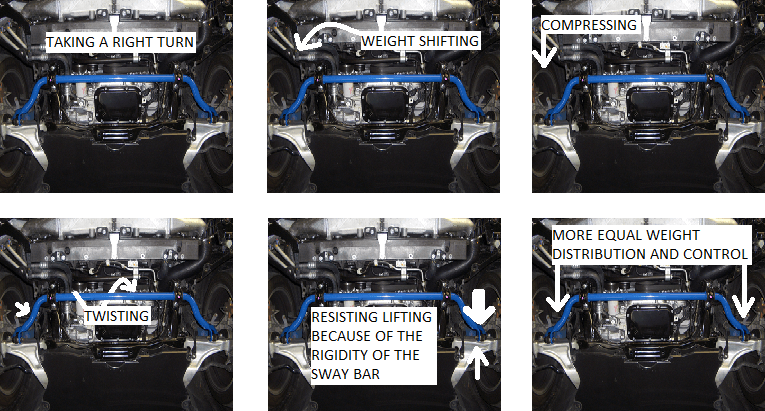The sway bar, also known as a stabilizer bar or anti-roll bar, is a crucial component in modern vehicle suspension systems. It connects the left and right wheels through torsion springs, influencing how the vehicle handles during cornering and uneven road surfaces. Many drivers notice a subtle but significant difference in their vehicle’s responsiveness, and the sway bar is frequently the unsung hero contributing to that feeling of control.
This article delves into the intricacies of sway bars, exploring their function, types, and impact on vehicle dynamics. Understanding the mechanics behind this seemingly simple bar unveils a deeper appreciation for the engineering that goes into crafting a safe and enjoyable driving experience.
The Fundamental Role: Mitigating Body Roll
The primary function of a sway bar is to reduce body roll during cornering. When a vehicle turns, centrifugal force acts on the center of gravity, causing the body to lean towards the outside of the turn. This phenomenon, known as body roll, can negatively impact handling and stability.
The sway bar counteracts this leaning force. It does so by transferring force from the wheel on the outside of the turn (which is experiencing increased compression) to the wheel on the inside of the turn (which is experiencing increased extension). This transference of force reduces the difference in vertical travel between the wheels, thereby minimizing body roll. Think of it as a mechanical intervention against the natural tendency of a vehicle to lean excessively.
How a Sway Bar Operates: Torsional Resistance
The sway bar operates on the principle of torsional resistance. It’s essentially a torsion spring that resists twisting. The ends of the sway bar are connected to the suspension components, typically the lower control arms or the chassis, via linkages and bushings.
When the vehicle is traveling straight, both wheels move vertically in a relatively uniform manner. The sway bar experiences minimal torsional stress. However, during cornering, the difference in vertical movement between the wheels induces a twisting force on the sway bar. This twisting is resisted by the bar’s inherent torsional stiffness. The bar effectively transmits a portion of the suspension load from one side of the vehicle to the other, leveling out the vehicle body and reducing body roll. The more robust the bar, the greater the resistance to torsion.
Sway Bar Stiffness: A Balancing Act
The stiffness of the sway bar plays a critical role in its effectiveness. A stiffer sway bar provides greater resistance to body roll, resulting in flatter cornering and improved handling. However, excessive stiffness can compromise ride comfort and reduce independent suspension articulation.
A stiffer sway bar, while improving handling on smooth surfaces, can negatively impact performance on uneven terrain. It may transmit more of the suspension movement from one wheel to the other, reducing the ability of each wheel to independently absorb bumps and undulations. The result can be a harsher ride and reduced traction. This is why engineers carefully calibrate sway bar stiffness, taking into account the vehicle’s intended use and target performance characteristics. It’s a delicate balancing act.
Types of Sway Bars: Diverse Designs for Diverse Needs
Sway bars come in various designs and configurations, each tailored to specific vehicle requirements and performance goals. Solid sway bars offer maximum stiffness for a given diameter, providing the most effective reduction in body roll. Hollow sway bars, on the other hand, can achieve comparable stiffness to solid bars with less weight, improving fuel efficiency and overall vehicle performance.
Adjustable sway bars offer the ability to fine-tune the suspension characteristics to suit different driving conditions and preferences. These bars typically feature multiple mounting points or adjustable linkages, allowing drivers to alter the effective stiffness of the bar. This adjustability can be particularly beneficial for performance enthusiasts who frequently track their vehicles or participate in autocross events.
Beyond Handling: Impact on Ride Quality and Stability
While sway bars are primarily associated with handling improvements, they also influence ride quality and stability. By reducing body roll, sway bars can improve the vehicle’s stability and reduce the likelihood of oversteer or understeer. A well-designed sway bar system contributes to a more predictable and controlled driving experience.
However, as previously mentioned, overly stiff sway bars can negatively impact ride comfort. Therefore, it’s crucial to choose a sway bar that strikes the right balance between handling performance and ride quality. The ideal sway bar setup will enhance the vehicle’s handling capabilities without sacrificing its everyday usability and comfort.
Upgrading Sway Bars: A Common Modification
Upgrading sway bars is a popular modification among performance enthusiasts. Aftermarket sway bars often offer increased stiffness compared to the factory-installed components, resulting in improved handling and reduced body roll. These upgrades can be a cost-effective way to enhance a vehicle’s performance, particularly for those who prioritize handling over ride comfort.
When upgrading sway bars, it’s important to consider the overall suspension setup and intended use of the vehicle. Matching the sway bar stiffness to the spring rates and damping characteristics of the shocks is crucial for achieving optimal performance. Consulting with a qualified suspension specialist can help ensure that the upgrade is properly implemented and that the desired results are achieved.
Maintenance and Longevity: Ensuring Optimal Performance
Sway bars, like all suspension components, require periodic maintenance to ensure optimal performance and longevity. The bushings and linkages that connect the sway bar to the suspension can wear out over time, leading to reduced effectiveness and increased noise. Regular inspection and lubrication of these components can help prevent premature wear and maintain the sway bar’s functionality.
Furthermore, the sway bar itself can be damaged by corrosion or impacts. Inspecting the bar for any signs of damage and addressing any issues promptly can prevent more serious problems down the road. With proper maintenance, a sway bar can provide years of reliable service and contribute to a safe and enjoyable driving experience. It’s a relatively simple component, but its impact is substantial.








Leave a Comment